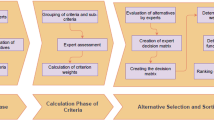Abstract
Existing decision-making methods for selection of feature operation chains normally only consider the processing requirements and neglect the impacts of the selected feature operation chain on the production line of the enterprise. As a result, the newly inserted manufacturing task may lead to a decrease in the manufacturing stability, which increases the malfunction probability of some machines and reduces production efficiency simultaneously. To solve this problem, a decision-making method for feature operation chain selection considering processing requirements and manufacturing stability is presented. The proposed method explores the factors affecting selection of a feature operation chain and develops a fuzzy comprehensive evaluation model of feature operation chain selection using hole feature as an example, thus realizing the selection of possible feature operation chains based on processing requirements. The method further applies a complex network theory to build an enterprise manufacturing network model, analyzes the manufacturing network stability, and then evaluates potential feature operation chains using a network stability index. Experimental results show that the proposed method is feasible and effective.
Similar content being viewed by others
References
Bhale S, Baki MF, Azab A (2014) Grouping and sequencing of machining operations for high volume transfer lines. Proc CIRP 17:76–81
Wong TN, Chan LCF, Lau HCW (2003) Machining process sequencing with fuzzy expert system and genetic algorithms. Eng Comput Ger 19(2):191–202
Joshi S, Chang TC (1988) Graph-based heuristics for recognition of machined features from a 3D solid model. Comput Aided Des 20(2):58–66
Sunil VB, Agarwal R, Pande SS (2010) An approach to recognize interacting features from b-rep cad models of prismatic machined parts using a hybrid (graph and rule based) technique. Comput Ind 61(7):686–701
Deb S, Ghosh K, Paul S (2006) A neural network based methodology for machining operations selection in computer-aided process planning for rotationally symmetrical parts. J Intell Manuf 17:557–569
Li Y, Liu J, Tao Y (2009) Selecting machining method based on fuzzy comprehensive evaluation. IEEE Int Conf Intell Comput Intell Syst 1:133–136
Hua GR, Zhou XH, Ruan XY (2007) Ga-based synthesis approach for machining scheme selection and operation sequencing optimization for prismatic parts. Int J Adv Manuf Technol 33:594–603
Guan X, Wang Y, Tao L (2009) Machining scheme selection of digital manufacturing based on genetic algorithm and AHP. J Intell Manuf 20:661–669
Wang M, Wang Z, Wang J (2010) Research on ann-based machining operation selection for rotational parts. J Univ Electron Sci and Technol China 39(3):470–474
Kumar A, Choi SK, Goksel L (2011) Tolerance allocation of assemblies using fuzzy comprehensive evaluation and decision support process. Int J Adv Manuf Technol 55:379–391
Guo L, Gao J, Yang J, Kang J (2009) Criticality evaluation of petrochemical equipment based on fuzzy comprehensive evaluation and a bp neural network. J Loss Prev Proc 22(4):469–476
Chu W, Li Y, Liu C, Mou W, Tang L (2014) A manufacturing resource allocation method with knowledge-based fuzzy comprehensive evaluation for aircraft structural parts. Int J Prod Res 52(11):3239–3258
Cohen R, Havlin S (2010) Complex networks: structure robustness and function. Cambridge University Press, New York
Zhao L, Diao G, Yan P, Yao Y, Chen H (2015) A gene recombination method for machine tools design based on complex network. Int J Adv Manuf Technol. doi:10.1007/s00170-015-7591-3
He P, Jing CG, Fan T, Chen CZ (2014) Robust decentralized adaptive synchronization of general complex networks with coupling delayed and uncertainties. Complexity 19(3):10–26
Qin Y, Zhao L, Yao Y, Xu D (2011) Multistage machining processes variation propagation analysis based on machining processes weighted network performance. Int J Adv Manuf Technol 55:487–499
Fu X, Small M, Chen G (2014) Propagation dynamics on complex networks: models, methods and stability analysis. Higher Education Press, Beijing
Shannon CE, Weaver W (1948) A mathematical theory of communication, 1948. Bell Syst Technol J 27(3):3–55
Author information
Authors and Affiliations
Corresponding author
Rights and permissions
About this article
Cite this article
Li, C., Mo, R., Chang, Z. et al. Decision-making of feature operation chain considering processing requirements and manufacturing stability. Int J Adv Manuf Technol 87, 1725–1737 (2016). https://doi.org/10.1007/s00170-016-8578-4
Received:
Accepted:
Published:
Issue Date:
DOI: https://doi.org/10.1007/s00170-016-8578-4




